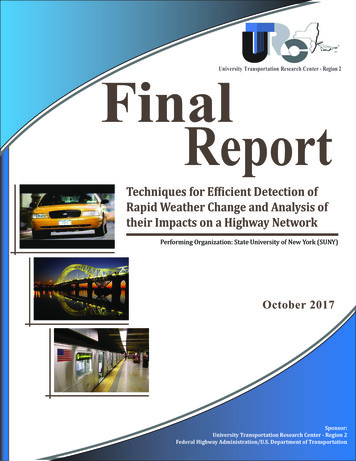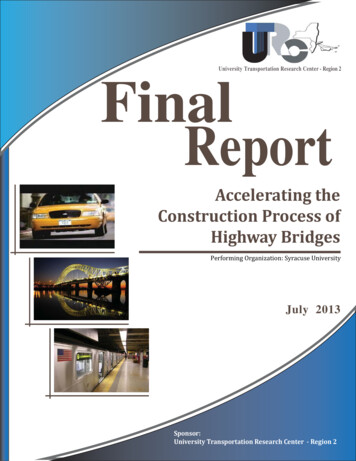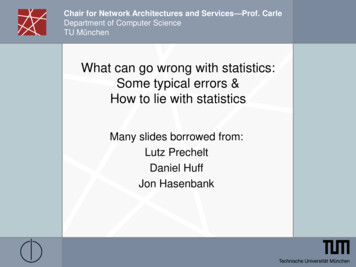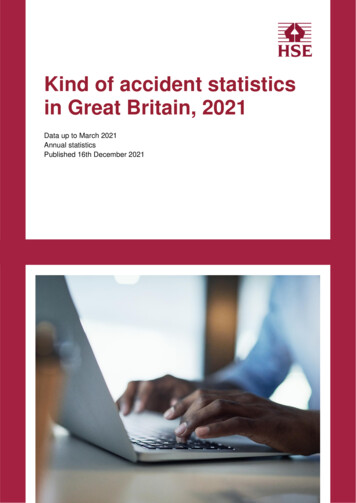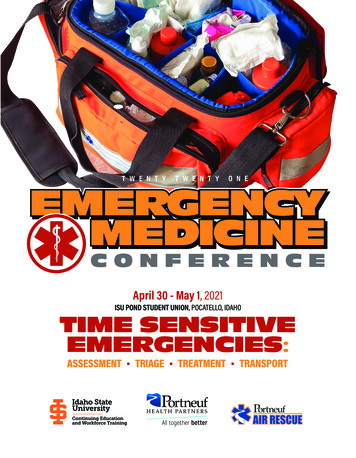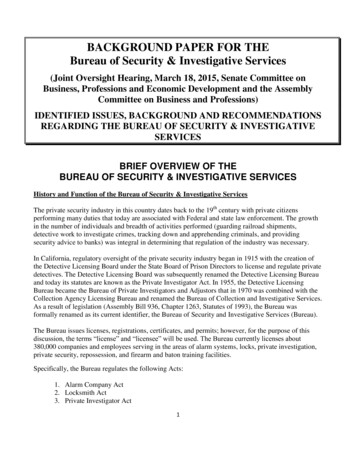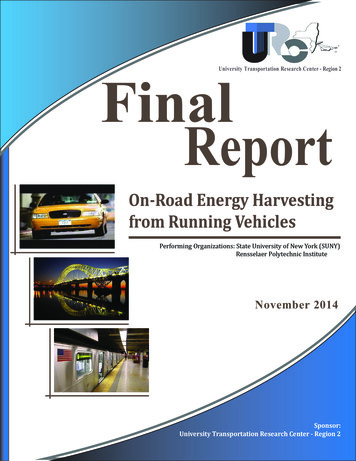
Transcription
FinalReportUniversity Transportation Research Center - Region 2On-Road Energy Harvestingfrom Running VehiclesPerforming Organizations: State University of New York (SUNY)Rensselaer Polytechnic InstituteNovember 2014Sponsor:University Transportation Research Center - Region 2
University Transportation Research Center - Region 2The Region 2 University Transportation Research Center (UTRC) is one of ten original UniversityTransportation Centers established in 1987 by the U.S. Congress. These Centers were establishedwith the recognition that transportation plays a key role in the nation's economy and the qualityof life of its citizens. University faculty members provide a critical link in resolving our nationaland regional transportation problems while training the professionals who address our transportation systems and their customers on a daily basis.The UTRC was established in order to support research, education and the transfer of technologyin the ield of transportation. The theme of the Center is "Planning and Managing RegionalTransportation Systems in a Changing World." Presently, under the direction of Dr. Camille Kamga,the UTRC represents USDOT Region II, including New York, New Jersey, Puerto Rico and the U.S.Virgin Islands. Functioning as a consortium of twelve major Universities throughout the region,UTRC is located at the CUNY Institute for Transportation Systems at The City College of New York,the lead institution of the consortium. The Center, through its consortium, an Agency-IndustryCouncil and its Director and Staff, supports research, education, and technology transfer under itstheme. UTRC’s three main goals are:ResearchThe research program objectives are (1) to develop a theme based transportation researchprogram that is responsive to the needs of regional transportation organizations and stakeholders, and (2) to conduct that program in cooperation with the partners. The program includes bothstudies that are identi ied with research partners of projects targeted to the theme, and targeted,short-term projects. The program develops competitive proposals, which are evaluated to insurethe mostresponsive UTRC team conducts the work. The research program is responsive to theUTRC theme: “Planning and Managing Regional Transportation Systems in a Changing World.” Thecomplex transportation system of transit and infrastructure, and the rapidly changing environment impacts the nation’s largest city and metropolitan area. The New York/New JerseyMetropolitan has over 19 million people, 600,000 businesses and 9 million workers. The Region’sintermodal and multimodal systems must serve all customers and stakeholders within the regionand globally.Under the current grant, the new research projects and the ongoing research projectsconcentrate the program efforts on the categories of Transportation Systems Performance andInformation Infrastructure to provide needed services to the New Jersey Department of Transportation, New York City Department of Transportation, New York Metropolitan TransportationCouncil , New York State Department of Transportation, and the New York State Energy andResearch Development Authorityand others, all while enhancing the center’s theme.Education and Workforce DevelopmentThe modern professional must combine the technical skills of engineering and planning withknowledge of economics, environmental science, management, inance, and law as well asnegotiation skills, psychology and sociology. And, she/he must be computer literate, wired to theweb, and knowledgeable about advances in information technology. UTRC’s education andtraining efforts provide a multidisciplinary program of course work and experiential learning totrain students and provide advanced training or retraining of practitioners to plan and manageregional transportation systems. UTRC must meet the need to educate the undergraduate andgraduate student with a foundation of transportation fundamentals that allows for solvingcomplex problems in a world much more dynamic than even a decade ago. Simultaneously, thedemand for continuing education is growing – either because of professional license requirementsor because the workplace demands it – and provides the opportunity to combine State of Practiceeducation with tailored ways of delivering content.Technology TransferUTRC’s Technology Transfer Program goes beyond what might be considered “traditional”technology transfer activities. Its main objectives are (1) to increase the awareness and level ofinformation concerning transportation issues facing Region 2; (2) to improve the knowledge baseand approach to problem solving of the region’s transportation workforce, from those operatingthe systems to those at the most senior level of managing the system; and by doing so, to improvethe overall professional capability of the transportation workforce; (3) to stimulate discussion anddebate concerning the integration of new technologies into our culture, our work and ourtransportation systems; (4) to provide the more traditional but extremely important job ofdisseminating research and project reports, studies, analysis and use of tools to the education,research and practicing community both nationally and internationally; and (5) to provideunbiased information and testimony to decision-makers concerning regional transportationissues consistent with the UTRC theme.Project No(s):UTRC/RF Grant No: 49997-51-24Project Date: November 2014Project Title: On-Road Energy Harvesting for Traf icMonitoringProject’s d-energyharvesting-traf ic-monitoringPrincipal Investigator(s):Dr. Lei ZuoEnergy Harvesting and Mechatronics Research LabDepartment of Mechanical EngineeringStony Brook UniversityStony Brook, NY 11794Tel: (540) 231-7270Email: leizuo@vt.eduCo-author(s):Dr. Jeff BanDepartment of Civil EngineeringRensselaer Polytechnic InstituteTroy, NY 12180Tel: (518) 276-8043Email: banx@rpi.eduLirong WangEnergy Harvesting and Mechatronics Research LabDepartment of Mechanical EngineeringStony Brook UniversityStony Brook, NY 11794Jinwoo ParkEnergy Harvesting and Mechatronics Research LabDepartment of Mechanical EngineeringStony Brook UniversityStony Brook, NY 11794Wanlu ZhouEnergy Harvesting and Mechatronics Research LabDepartment of Mechanical EngineeringStony Brook UniversityStony Brook, NY 11794To request a hard copy of our inal reports, please send us anemail at utrc@utrc2.orgMailing Address:University Transportation Reserch CenterThe City College of New YorkMarshak Hall, Suite 910160 Convent AvenueNew York, NY 10031Tel: 212-650-8051Fax: 212-650-8374Web: www.utrc2.org
Board of DirectorsUTRC Consortium UniversitiesThe UTRC Board of Directors consists of one or two members from eachConsortium school (each school receives two votes regardless of thenumber of representatives on the board). The Center Director is anex-of icio member of the Board and The Center management teamserves as staff to the Board.The following universities/colleges are members of the UTRC consortium.City University of New YorkDr. Hongmian Gong - Geography/Hunter CollegeDr. Neville A. Parker - Civil Engineering/CCNYClarkson UniversityDr. Kerop D. Janoyan - Civil EngineeringColumbia UniversityDr. Raimondo Betti - Civil EngineeringDr. Elliott Sclar - Urban and Regional PlanningCornell UniversityDr. Huaizhu (Oliver) Gao - Civil EngineeringHofstra UniversityDr. Jean-Paul Rodrigue - Global Studies and GeographyManhattan CollegeDr. Anirban De - Civil & Environmental EngineeringDr. Matthew Volovski - Civil & Environmental EngineeringNew Jersey Institute of TechnologyDr. Steven I-Jy Chien - Civil EngineeringDr. Joyoung Lee - Civil & Environmental EngineeringNew York UniversityDr. Mitchell L. Moss - Urban Policy and PlanningDr. Rae Zimmerman - Planning and Public AdministrationPolytechnic Institute of NYUDr. Kaan Ozbay - Civil EngineeringDr. John C. Falcocchio - Civil EngineeringDr. Elena Prassas - Civil EngineeringRensselaer Polytechnic InstituteDr. José Holguín-Veras - Civil EngineeringDr. William "Al" Wallace - Systems EngineeringRochester Institute of TechnologyDr. James Winebrake - Science, Technology and Society/Public PolicyDr. J. Scott Hawker - Software EngineeringRowan UniversityDr. Yusuf Mehta - Civil EngineeringDr. Beena Sukumaran - Civil EngineeringState University of New YorkMichael M. Fancher - NanoscienceDr. Catherine T. Lawson - City & Regional PlanningDr. Adel W. Sadek - Transportation Systems EngineeringDr. Shmuel Yahalom - EconomicsCity University of New York (CUNY)Clarkson University (Clarkson)Columbia University (Columbia)Cornell University (Cornell)Hofstra University (Hofstra)Manhattan College (MC)New Jersey Institute of Technology (NJIT)New York Institute of Technology (NYIT)New York University (NYU)Rensselaer Polytechnic Institute (RPI)Rochester Institute of Technology (RIT)Rowan University (Rowan)State University of New York (SUNY)Stevens Institute of Technology (Stevens)Syracuse University (SU)The College of New Jersey (TCNJ)University of Puerto Rico - Mayagüez (UPRM)UTRC Key StaffDr. Camille Kamga: Director, Assistant Professor of Civil EngineeringDr. Robert E. Paaswell: Director Emeritus of UTRC and DistinguishedProfessor of Civil Engineering, The City College of New YorkHerbert Levinson: UTRC Icon Mentor, Transportation Consultant andProfessor Emeritus of TransportationDr. Ellen Thorson: Senior Research Fellow, University TransportationResearch CenterPenny Eickemeyer: Associate Director for Research, UTRCDr. Alison Conway: Associate Director for EducationNadia Aslam: Assistant Director for Technology TransferNathalie Martinez: Research Associate/Budget AnalystTierra Fisher: Ofϔice AssistantBahman Moghimi: Research Assistant;Ph.D. Student, Transportation ProgramWei Hao: Research FellowAndriy Blagay: Graphic InternStevens Institute of TechnologyDr. Sophia Hassiotis - Civil EngineeringDr. Thomas H. Wakeman III - Civil EngineeringSyracuse UniversityDr. Riyad S. Aboutaha - Civil EngineeringDr. O. Sam Salem - Construction Engineering and ManagementThe College of New JerseyDr. Thomas M. Brennan Jr - Civil EngineeringUniversity of Puerto Rico - MayagüezDr. Ismael Pagán-Trinidad - Civil EngineeringDr. Didier M. Valdés-Díaz - Civil EngineeringMembership as of January 2016
DISCLAIMERThe contents of this report reflect the views of the authors, who are responsible for the factsand the accuracy of the information presented herein. The contents do not necessarilyreflect the official views or policies of the UTRC, or the Research and InnovativeTechnology Administration. This report does not constitute a standard, specification orregulation. This document is disseminated under the sponsorship of the Department ofTransportation, University Transportation Centers Program, in the interest of informationexchange. The U.S. Government assumes no liability for the contents or use thereof.ii
1. Report No.2.Government Accession No.TECHNICAL REPORT STANDARD TITLEPAGE3. Recipient’s Catalog No.4. Title and Subtitle5. Report DateOn-Road Energy Harvesting for Traffic MonitoringNov 20146. Performing Organization Code7. Author(s)8. Performing Organization Report No.Lirong Wang, Jinwoo Park, Wanlu Zhou, Jeff Ban, and Lei Zuo9. Performing Organization Name and Address10. Work Unit No.Stony Brook University, Stony Brook NYRensselaer Polytechnic Institute (RPI) Troy, NY11. Contract or Grant No.12. Sponsoring Agency Name and Address13. Type of Report and Period CoveredUniversity Transportation Research Center-Region II, City College of Final Report (2012-2014)New York, 138th St. & Convent Ave., New York, NY 1003114. Sponsoring Agency Code15. Supplementary Notes16. AbstractA new type of large-scale on-road energy harvester to harness the energy on the road whentraffic passes by is developed. When vehicles pass over the energy harvesting device, theelectrical energy can be produced by the mechanical motion even after the vehicle passed by,which solves the difficulty in regeneration energy from impulse vibration. Design approachand dynamics modeling are presented to reveal the working mechanism of the energyconversion. In-field test with a sedan car is carried out and the regenerated power up about24 Watts can be produced, which is much larger than the existing highway energy harvesterin the published literature. This large-scale energy harvesting mechanism using the proposedMMR mechanism can help to develop harvesting device to build up self-power energy sourcefor highway transportation monitoring system.17. Key Words18. Distribution StatementOn-road energy harvesting; vibration energyharvesting; kinematic energy harvesting;electromagnetic19. Security Classif (of this report)20. Security Classif. (of this page)UnclassifiedUnclassified21. No of Pages28Form DOT F 1700.7 (8-69)iii22. Price
Executive SummaryThe highway transportation plays a very significant role in the nationwide economy andsociety development, including in UTRC2 area. For the routine traffic management and futureplanning of the highway infrastructure and other transport systems associated with it, a reliabletraffic monitoring system is highly needed along the highways. However, the cost-effective,convenient and reliable power supply needed for the traffic monitoring system is still a bigchallenge. The objective of this project is to develop a sustainable solution of on-site energy tothe critical challenge and power demand for traffic monitoring systems, by harvesting the energyfrom the road using smart motion mechanism.We proposed an innovative type of high energy density, compact energy harvester. Thiscuboid-shape energy harvester is designed to be installed under the road surface. When a car runsover the road surface, specifically above the top plate, the car’s weight and running speed giveimpact-like input to the top-plate and this input power is used to rotate the main shaft of theharvester which is connected to the generator. As soon as the car’s front wheel passes by the topplate, top plate will recover to initial position before the rare wheel arrives. To achieve this goal,one-way clutch was installed to joint between the top plate and main shaft, and a spring wasinstalled under the joint part. In addition to decrease the time and cost of the installationconstruction, the harvester was designed in very compact size (6" 6" 15") and the speciallydesigned detachable joint allows the power train part can be easily exposed by removing the topplate. The most significant advantage of the proposed design over traditional energy harvesters isour design will not slow down the speed of the traffic while it harvests energy from runningvehicles.Theoretical modeling, simulation, and experiment test of the proposed on-road energyharvester has been conducted. The simulation and experiment results verified the effectiveness ofthe proposed design. After the lab test we will install the on-road energy harvester prototype inStony Brook University campus for in-field test.1
1. INTRODUCTION1.1 Background and SignificanceFor the problem of natural resources shortage, US Department of Energy said “energycrisis” is only a small example of what will happen to us in the future [1]. The speed of energyconsumption has been faster than the speed of natural resources re-generation for many years. Inthis sense, numerous researchers are working on technologies for renewable energy harvesting,and exploring to increase the energy harvesting efficiency of the energy harvester system.Almost all the people in the United States need to use highways very often, in the formsof riding cars, taking buses, etc. The power supply and associated maintenance are importantissues for traffic monitoring and detection system, which is critical for transportation safety andmobility. The challenge is due to not only the fact that the transportation sector consumes almostone-third of the nation’s energy (Bureau of Transportation Statistics, 2007 [2]), but also the factthat the transportation system covers such a large portion of the nation’s surface area andproviding traditional power supply (such as grid power) is extremely difficult, if not impossible,to certain areas such as remote areas [3].Inductive loop detector, composing a big metallic loop buried under the pavement, is themost widely used technology today including in UTRC2 area because of its high accuracy.However, there is currently a significant gap national wide in providing energy supply to coverthe entire monitoring and detection system. This particularly true for traffic sensing and detectionpurposes as existing traffic monitoring sensors and communication infrastructures rely heavilyon grid power and/or batteries. In remote areas, grid power and communication lines aresometimes technically or economically impossible to access. Wireless sensors may provide apromising solution but still with significant challenge in battery energy supply. The SenSysvehicle detection sensors, for example, have been installed in some of the nation’s freeways andarterials. Such devices are primarily powered by batteries. The battery life is claimed to be 2-10years (repeaters and nodes), but needs to be verified in high-volume traffic and in extremetemperatures. The highway pavements are typically designed for 20 years cycle life, and somestates like Minnesota have extended the pavement design life standard to 40-60 years. Replacingmillions of batteries for tens of thousands of wireless sensors would be a huge logistic problem.2
And the maintenance cost could be huge to replace batteries of sensor nodes embedded in thepavement. Another important concern is the environmental impact of disposing the used batteries.For solving the power supply problems in traffic monitoring system, especially in remoteregions, an innovative idea is proposed in this project, which is using a smart motion mechanismto convert the motions due to the passing vehicles on highways to electrical energy. It is a greenregenerative energy harvesting system. On the other hand, due to the wide deployment of energyharvesters on the highway system, grid power is eliminated or is only deployed at limited places(like near major infrastructures for monitoring and communication purposes). As a result, thetime and cost are significantly reduced for grid power installation and battery replacementswithin the highway system. The total energy consumption of the transportation system is alsomuch reduced, which leads to a more sustainable transportation system.1.2 Literature ReviewAs one of the most popular type of existing road energy harvesters, many researchers areworking on piezoelectric material. Piezoelectric materials are widely using in energy harvestingarea to generate energy to power low energy consuming equipment [4]. Piezoelectric generatingunits have advantage of compactness of design. However, the drawbacks of using piezoelectricmaterial is the amount of harvesting energy is order of μW. As one of the most recent work, RuiLi et al. introduces piezoelectric vibrator can be mount on the road [5]. According to the result ofthe study, their single unit of energy harvester was able to generate 2.67mJ theoretically.Brandon Alexander Hall did investigation on piezoelectric film to check whether it can generateenough energy to translate signal through RF transmitter [6]. He used 52μm film of polyvinylidene fluoride, and his prototype could generate the energy with range of 400-800μJ when acar run over the film which was around 4-8 times of required power to transmit 4 packets of 12bit of data with his transmitter. Haim Abramovich et al. published patent of energy harvestingunit for on-road and airport runway by using piezoelectric material [7]. His work produced as aproduct in energy harvesting company name of Innowattech. Innowatech claims that their onroadenergy harvester unit can generate 200kw/h for 1km lane of road [8]. However it is hard tobelieve its validity because there isn’t practical product which is been using.The other type of popular road energy harvester is electromagnetic energy harvester.Electromagnetic energy harvester generate electricity by absorbing the external vibration into the3
moving part of the harvester. If the moving part is magnet, then fixed part of the harvester shouldbe coil and vice versa. The benefits of using electromagnetic energy harvester is, the limitationof size of harvester is not crucial as much as piezoelectric energy harvester. Compared withpiezoelectric energy harvesters which should ensure large contact area or large number of unitsto generate large amount of energy, electromagnetic harvester can make one unit powerful byusing strong magnet and heavy weight of moving mass. When we consider the output powerform one unit of harvester, an electromagnetic harvester’s output can be much larger than apiezoelectric material energy harvester. Also electromagnetic harvester generate comparablyhigh current output. On the contrary, most of the electromagnetic energy harvester has larger sizethan piezoelectric material harvester and generate comparably low voltage [9]. One of the mostpractical electromagnetic road energy harvester provider is Highway energy service LTD, inUnited Kingdom. The inventor of the harvester says the output power of a one unit of harvesteris depends on the speed of the cars and period of running over cars, but generally able togenerate 5 to 10kW of energy [10].Mechanical vibration and motion have gained a lot of attention due to reasonable energydensity, embedability, and less dependence on weather conditions. We found several mechanicalvibration energy harvester patents. Calvo [11] proposed a kind of highway power generator in2004, as shown in Figure 1. When a car runs over the actuator buttons 3, input load is transmittedto the recoiling spring 30, which will hit the connection part 56 and it will rotate the main shaft15 to drive generator. The disadvantage of the system is that due to so many components in thesystem, the structure is too complicated, which may increase the maintenance cost. Meanwhile,the complexity will result in low energy harvesting efficiency.Figure 1. Highway electric power generator [11]4
Another type of road energy harvester is shown in Figure 2. When a car runs over thebumps 12, the bumps are pushed down and this vertical motion rotates cranks 19, which willrotate the alternator 20 and generate electricity [12]. The disadvantage of the system is that itrequires a lot of space underneath the road, and the design is not compact enough.Figure 2. Roadway power generating system [12]Martinez [13] proposed a “highway turbine” energy harvester, as shown in Figure 3. Thesystem uses ratchet mechanism to rotate the big gear. The drawback of this design is the pedalpart 39 on the road surface, which will slow down the traffic. According to the highwayregulation of NYC they don't allow any extruded structure on the highway in safety purpose. Thepotential disaster is that when a vehicle changes lane but the drive didn’t notice the pedalstructure on the road, it will cause big accident or at least severe damage to the vehicle.Figure 3. Highway turbine [13]5
2. DESIGN and PROTOTYPE2.1 Concept designAs shown in Figure 1, vehicle tires rollover a harvester installed under road ground, theweight of the car pushes the top plate of the harvester downward, which drives theelectromagnetic generator to rotate and to product electrical energy. The concept design of theon-road energy harvester is demonstrated in Figure 2 (a). Designed parameter of the verticalstroke of the harvester and the width of the top plate in the vehicle lateral direction aredetermined according the average tire deformation between contact patch and the wheel hub, bywhich the tire deformation caused by the by the interaction with the top plate is in the same rangeas that when the tires roll over on ground. Thus, the response of vehicle passing through theharvester is similar to that rolling over on the ground, by which vehicle movement will be notinfluenced when passing through the harvester. Therefore, when tires pass through the harvester,the normal force reacting from the harvester to tires will not change much than that reactingforce from the ground, and the vehicle need not to be slowed down.Fig. 1. The schematic of on-road energy harvester6
(a)Whole structure of on-road energy harvester(b) Kinetic energy conversion mechanism of mechanical motion rectifier(b) Kinetic energy conversion mechanism of mechanical motion rectifierFig. 2. Concept design of on-road energy harvesterFig. 2. Concept design of on-road energy harvesterIn order to regenerative maximum energy, a high efficient energy conversion mechanismof mechanical motion rectifier (MMR) is designed as shown in Figure 2(b), which includes oneshaft, one pair of arm-cam, two pair of one-way bearings, a gearbox, a generator and a flywheel.The one-way bearing embedded in the cam is similar to the one used in bicycle gears or enginestarters to transmit motion in one direction. When the top plate moves downward, the one-waybearing is engaged, and the generator is driven to rotate and to produce electricity. When the topplate move upward under the rebound force from the supporting spring, the one-way bearing isdisengaged from the generator shaft, and the generator can continuous to rotate under inertiamoment to produce more electricity. Thus the generator can always rotate in one direction, which7
can achieve high energy transmission efficiency and lessen backlash to make the harvester to bemore reliable.This MMR design in engagement and disengagement in one-direction is actually a halfwave function of the MMR, which can transfer two direction vibrations into one direction asdeveloped in our other energy harvesters the authors [12-16]. This half-wave form MMRmechanism can solve the fundamental problem in large-scale impulse vibration energyharvesting due to short-time shock from vehicle to the harvester to achieve high energyharvesting efficiency. The gearbox is used to increase the rotation speed of shaft to the generatorand to increase the electrical transmission energy of the generator.There is another one-way bearing embedded between the flywheel and the shaft. Oncethe flywheel spins at higher speed than the shaft, the one-way bearing disengage flywheel fromthe shaft, which can absorber the shock energy and protect the regenerator to be drasticallydriven by gearbox. Later on, the energy stored in flywheel can be released smoothly to thegenerator and improve the energy transmission efficiency and working reliability.In order to regenerate more energy from the twice impulses movements of the harvestercaused by the front and rear wheel tires without influence to the vehicle speed, a special flexibleconnection between the following arm and cam structure is designed, as shown in Figure 3 (b).The interaction between the arm and cam is in contact connection to avoid fixed connection inorder to disengage the top plate from the generator shaft much easily without any screwingconnection. Moreover, the disengagement of the one-way bearing in half-wave form MMR alsoenables the cam to be quickly disengaged with the following arm and to recover the top plate toits original position. Since the speed of vehicle need not to be slowed down and the wheelbasebetween the axles of front and rear is limit, the time duration between the front and rear tirespassing through the harvester is very short. A kind of quick rebound mechanism of the top plateto its original position after the front tires run over the top plate and before the rear tires touchthe harvester is designed by using a set of supporting springs and position limitations to the topplate. The set of reset springs can enable the top plate to reset its original positon in short timeafter vehicle tires pass through the harvester, and then the top plate of the harvester can beprepared for the next downward press to regenerate energy. The rebound time of the spring setrecovering from the maximum pressed position after the front axle pushes down the springs is8
important to make the plate to its original position before the rear wheel axle contacts with it. Ifthe top plate can be pushed down again in its maximum displacement by the rear wheel, thetwice press shocks from both front and rear tires can regenerate electricity energy twice toincrease the harvesting energy.The design parameters of stiffness of supporting springs and the displacement of the topplate are important to meet the requirement of quick rebound, which need to be carefullyconsidered according to the time between the two wheel axles passing through the harvests. Theposition limiters can constraint the movement of the top plate in a certain range and also help tosecure its continuous working to produce more electricity when many vehicles pass bycontinuously. Furthermore, the shape design of the following arm is important to reduce thecontact area for improvement of the energy conversion efficiency, lessen the recovering time andto increase the reliability of both arm and came. Since the large shock transferred from tires toarm-cam connection, the strength of the arm and the friction between the contact surfaces of armand cam are critical to the reliability of the structure. Figure 3 demonstrates the optimized shapeof the arm with sharp end instead of round end based on finite element analysis of the arm-caminteraction. This proposed flexible contact interaction can simplify the structural parts, improvethe energy harvesting efficiency, reduce the cost for production and release the maintenance loadwithout influence to vehicle traffic on road.Fig. 3. Finite element analysis of following arm9
2.2 PrototypingThe fabricated prototype is as illustrated in Figure 4. The size of the top plate is length of0.406m and width of 0.152m, t
Mailing Address: University Transportation Reserch Center The City College of New York Marshak Hall, Suite 910 160 Convent Avenue New York, NY 10031 Tel: 212-650-8051 . Hofstra University Dr. Jean-Paul Rodrigue - Global Studies and Geography Manhattan College Dr. Anirban De - Civil & Environmental Engineering .
